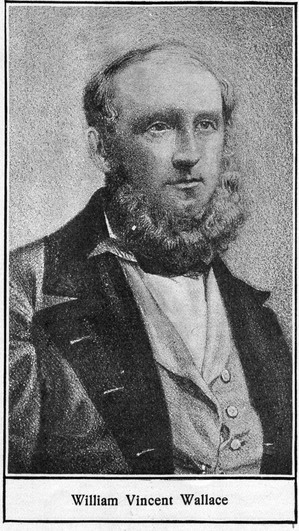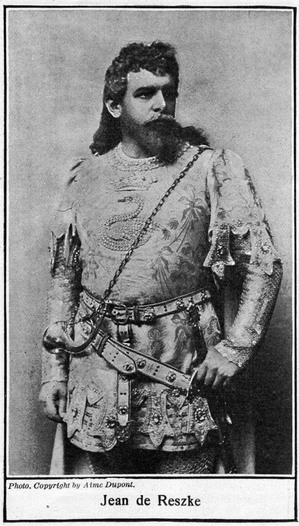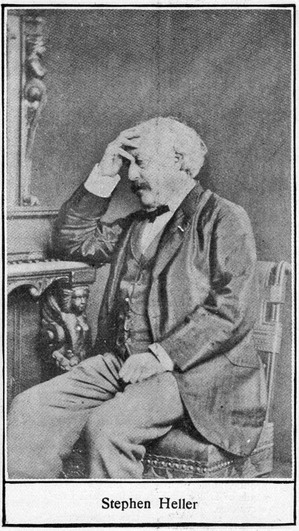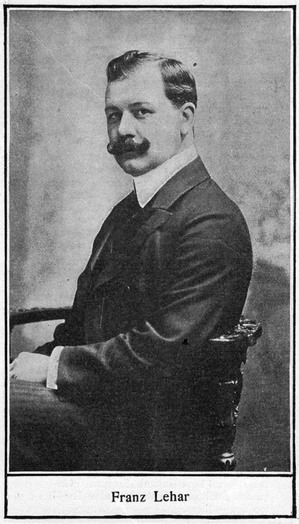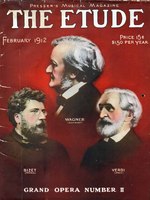Wallace was born at Waterford, Ireland, July 1, 1813, and died at the Chateau de Bergen, in the Pyrenees, Oct. 12, 1865. The family migrated to Dublin, and Wallace soon became known as a violinist, organist and conductor. He went to Australia in 1835, and for a time lived adventurously by sea and land. In 1845 he found himself in London. Maritana was written and produced at Drury Lane the same year, and established Wallace’s reputation. Other operas followed, but in 1849 he was in charge of a concert party in South America. Fourteen years in Germany folowed (sic), where his piano music was in great demand. Little of it is now remembered, though his first Polka de Concert and the piano arangement (sic) of Paganini’s Witches’ Dance are still with us. He was invited to write an opera for Paris, but his eyesight failed him, and he undertook another trip to North and South America. He lost a fortune in New York, but made another by concert work, and returned to London in 1853. His Lurline was produced at Covent Garden in 1860, and was followed by other operas, now mostly forgotten. Wallace had remarkable gifts as a composer, but suffered from a “fatal facility” which led to the production of many works of no permanent value. His taste for adventure also interfered with his success to a great extent. His tuneful Maritana, however, will always delight lovers of simple melody.
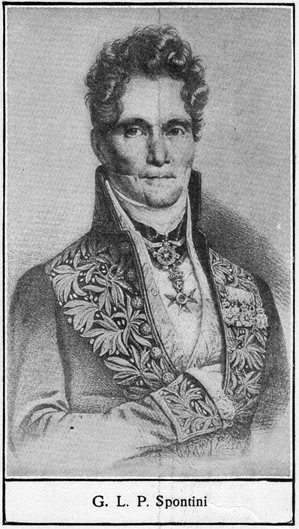 GASPARO LUIGI PACIFICO SPONTINI.
GASPARO LUIGI PACIFICO SPONTINI.
(Spon-tee’-ne) Spontini was born at Majolati, Ancona, Nov. 14, 1774, and died there Jan. 24, 1851. He studied at the Conservatory, Naples, under Sala and Tritto. His success as a composer also won him valuable assistance from Piccinni. He won distinction in Naples, Venice, Rome and elsewhere as an opera composer, and then proceeded to Paris. Here he found that the facile Neapolitan style of opera was regarded with some contempt, and he made Mozart and Gluck his models. This resulted in the production of La Vestale, in 1807, and he became a great favorite. Napoleon and the Empress Josephine encouraged him in his work. Ferdinand Cortez proved almost as successful as La Vestale. He became director of Italian Opera, 1810-12, but was dismissed for “financial irregularities.” The post was restored to him by Louis XVIII, but he sold it to Catalani. His last year in Paris (1819) witnessed the production of Olympie, a work which failed at first, but after much revision became a great favorite. From 1820 to 1841 he was in Berlin as court composer to Frederick II. Spontini became a brilliant figure at the German court, but created far more enemies than friends. After the death of the Emperor he was superseded, narrowly escaping imprisonment and disgrace. In recognition of his past services, however, he was pardoned and well pensioned.
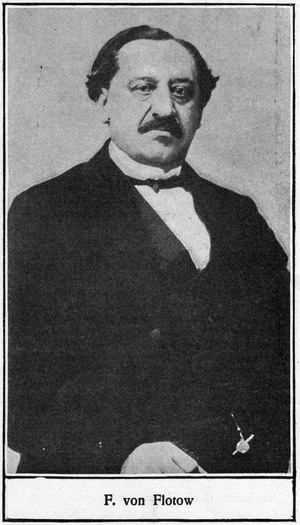 FRIEDRICH VON FLOTOW.
FRIEDRICH VON FLOTOW.
(Flo’-toh.)
Flotow was born near Mecklenburg, and died at Darmstadt, January 24, 1883. He was the son of a German nobleman and was educated for the diplomatic service. The love of music, however, proved too strong for him, and when he went to Paris in 1827 he yielded to his musical aspirations, and became a pupil of Reicha. The Revolution of 1830 drove him away for a time, but he soon returned to Paris, and produced his first attempts at the houses of his aristocratic friends. His first operatic success in public was a work entitled Le Naufrage de la Méduse, produced at the Théâtre de la Renaissance, 1839. It was afterwards re-written and produced in Hamburg, 1845, and became a popular favorite in Germany. Several operas and ballets followed with varying success. The best known of his works are the operas Stradella and Martha. Stradella was originally a short lyric piece, and was afterwards enlarged into operatic form, and achieved great popularity in Germany, though it failed in London, and was never produced in Paris. Martha is the best and also the most popular of all his works. It was produced in Vienna, 1847, and quickly spread all over the world. In 1856 Flotow was appointed Intendant at the Court theatre, Schwerin, a post he retained until 1863, when he returned to Paris. In 1868 he removed to the neighborhood of Vienna.
De Reszke was born at Warsaw, Poland, Jan. 14, 1850. He studied with Ciaffei, Cotogni and Sbriglia. He made his first operatic appearance in Venice, 1874, and sang in London, 1875. He was then supposed to be a baritone and as such made a reputation for himself not only in London, but also in Paris and Italy. He first appeared as a tenor in Madrid, 1879, and was first tenor at the Paris Opera, 1884-1889. He appeared in the first productions of many famous operas, including Gounod’s Roméo et Juliette, and Massenet’s operas, Le Cid and Herodiade. He made his début at Covent Garden, in 1888, and appeared there every year until 1900, his parts including John of Leyden, the Duke in Un Ballo, Don José, Phoebus, in Goring Thomas’s Esmeralda, Lancelot in Bemberg’s Elaine, and Werther in Massenet’s opera. He became especially famous, however, as a singer in Wagner’s operas, and in parts such as Walther, Siegfried and Tristan he was unrivalled. He made his New York début in 1895, and though he was something of a failure at first, he soon established himself as the world’s leading tenor. The most remarkable thing about De Reszke perhaps was his method of singing the heavy Wagner rôles in which he admirably interpreted the dramatic side, without sacrificing vocal purity. He suffered a severe illness in 1904, and since then has been engaged in teaching in Paris.
Heller was born May 15, 1815, at Pesth, Hungary, and died in Paris, Jan. 14, 1888. He studied with Anton Halm, in Vienna, and at an early age made his début in Pesth. After a tour through Germany he settled in Augsburg, 1830-33, where he suffered a prolonged illness, and added to his stock of musical knowledge during his recovery. He went to Paris in 1838, and quickly established himself as a teacher of unusual ability. He rarely appeared in public, though he gave concerts in London in 1850 and again in 1862. His main life-work, however, was teaching and composing for the piano. The value of his teaching experience is noticeable in his admirable Studies, which have proved of immense value to students—particularly Opus 16, Nos. 45, 46 and 47. Of his other compositions, the Tarantelle in A flat (Op. 85) is by far the most popular. It is probably the most familiar example of this famous Italian dance in existence. He also wrote many other excellent pieces of marked originality, such as Les Nuits Blanches, and Im Walde. His knowledge of the pianoforte is further shown in the excellent transcriptions of many of the Schubert and Mendelssohn compositions. He does not appear to have attempted to write large orchestral works, but confined himself to the smaller forms, in which he was very prolific. One of the best known of his pupils of Isidor Philipp, of the Paris Conservatoire.
Lehar was born April 30, 1870, at Komárom, Hungary. He received his musical education at the Prague Conservatory, and from there went as concertmaster to Elberfeld-Barmen. Subsequently he became a military bandmaster, and served with many infantry regiments in various parts of Austria-Hungary. He left the army in 1902 to fill the post as conductor of the Vienna Theater. In this year he also acted as conductor of the Riesenorchesters—the Giant Orchestra—at “Venice in Vienna,” a great exhibition held in the Austrian capital. Lehar will always be remembered as the composer of The Merry Widow, the most successful musical comedy of recent times. It was produced in Vienna, 1905, and its entrancing waltz tunes spread across Europe and America like a summer heat-wave. Gipsy Love has also proved popular in this country, and so have other works of his which have been produced in German in America. He has also composed marches, overtures, and a symphonic poem. Like our own Victor Herbert, Lehar is one of a small band of well-schooled composers the world has produced, who has succeeded in appealing to the mass of people by their melodious and vivacious charm, and at the same time have delighted trained musicians by their certainty of technique. Mozart paved the way with his Magic Flute and The Marriage of Figaro, and since him there have been Johann Strauss, Planquette, Sullivan, Offenbach, and a few— too few—others.


